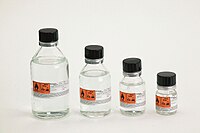
Photo from wikipedia
Coordination-induced bond weakening is a phenomenon wherein ligand X-H bond homolysis occurs in concert with the energetically favorable oxidation of a coordinating metal complex. The coupling of these two processes… Click to show full abstract
Coordination-induced bond weakening is a phenomenon wherein ligand X-H bond homolysis occurs in concert with the energetically favorable oxidation of a coordinating metal complex. The coupling of these two processes enables thermodynamically favorable proton-coupled electron transfer reductions to form weak bonds upon formal hydrogen atom transfer to substrates. Moreover, systems utilizing coordination-induced bond weakening have been shown to facilitate the dehydrogenation of feedstock molecules including water, ammonia, and primary alcohols under mild conditions. The formation of exceptionally weak substrate X-H bonds via small molecule homolysis is a powerful strategy in synthesis and has been shown to enable nitrogen fixation under mild conditions. Coordination-induced bond weakening has also been identified as an integral process in biophotosynthesis and has promising applications in renewable chemical fuel storage systems. This review presents a discussion of the advances made in the study of coordination-induced bond weakening to date. Because of the broad range of metal and ligand species implicated in coordination-induced bond weakening, each literature report is discussed individually and ordered by the identity of the low-valent metal. We then offer mechanistic insights into the basis of coordination-induced bond weakening and conclude with a discussion of opportunities for further research into the development and applications of coordination-induced bond weakening systems.
Journal Title: Chemical reviews
Year Published: 2022
Link to full text (if available)
Share on Social Media: Sign Up to like & get
recommendations!